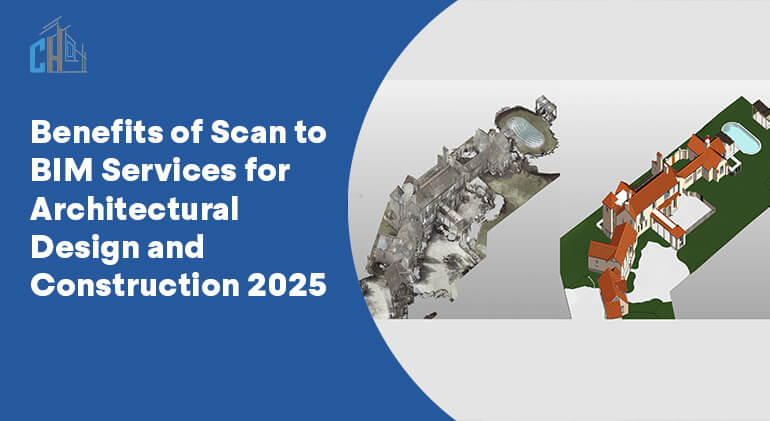
A new age in architectural designing and construction has been re-engineered through Scan to BIM Modeling services, thus massively reducing errors and saving time and money.
The above online resources allow easy visualization, detailed planning, and smooth workflow involving all the involved parties. The use of laser scanning technology offers a more consistent way of building design, leading to a better process in construction projects.
In today’s ever-changing architecture and construction universe, technology integration with innovative trends is evident and necessary.
BIM services are increasingly scanning technology among these latest developments, where they are unusually reshaping the industry. With this technology, the whole concept of designing and building gets simplified and is loaded with subsequent benefits that have the potential to improve project results.
This post article deals with the essence of Scan to BIM Modeling services dedicated to architects, construction, and BIM specialists in the US, touching on the following topics: saving time, minimizing project costs, and creating a future of architectural design.
Scanning to BIM stands for the procedure whereby point cloud data from laser scanners is being turned into a detailed and accurate digital 3D model that can help in BIM software systems. This technology measures the live physical reality of the design, providing exact 1:1 digital representation, which in turn serves as the guiding tool for the design, planning, development, and management of the construction site.
The Evolution of Architectural Design and Construction with BIM
The inclusion of BIM has profoundly impacted today’s architectural and construction practices, shifting the views that dominated the industry from 2D drafting to interdimensional visualization.
BIM Modeling services provide all the concerned people with graphs of how the building will stand in space, the simulation of daylight, the geographic information system, and the measurement of properties and types of building elements.
An additional advantage of the scan to BIM services is the inclusion of real-life data into BIM models. It helps the project teams to be more controlled and more universal based on the responses of all teams.
The Role of Scan to BIM
Scan to BIM services shorten the project workflow cycle dramatically by adding a level of precision and detail through the provision of faithful representations of the existing condition.
This accuracy minimizes the requirement for pairwise measurements and subsequent site visits, that is, time and resource-savers. It is particularly beneficial in line with design errors, and the construction phase makes the job of the contractors smoother and results in high quality.
The Advantages of Scan to BIM Services
The benefits of Scan to BIM services are significant in saving time and reducing the overall cost of the projects because they are not just a tool for enhancing project performance. Moreover, they encompass more precise cost management, expanded opportunities for partnerships, and innovative design and construction approaches.
The use of real-world data in the Revit modeling services can help stakeholders gain a better comprehension of the project scope so as to identify possible bugs before they expense more changes and develop a high-quality product with the budget allocated. So, the level of understanding and germane detail of planning to the project lifecycle results in high-cost cutting throughout the project.
Additionally, the importance of Scan to BIM creates a more collaborative environment by having the exact common digital coordinates on everyone’s projects. Whether it’s the architects, engineers, contractors, or clients, they can all view the same model with all the information that they require.
Therefore, this solves the communication problem and helps in building unanimity. The collective effort in the project pipeline not only simplifies workflows in projects but also improves the quality of overall development.
Case Studies Highlighting the Benefits of Scan to BIM
A large number of projects demonstrated in the United States the efficiency of Convert Point Cloud to 3D Model for Building Information Modeling (BIM) using Scanning to Building Information Modeling (BIM). To illustrate, a project of historic building renovation where the traditional measurement methods would have been slow and less accurate was accelerated by using Scan to BIM technology.
The produced 3D model enabled not only architects and construction workers but also designers to find the existing problems and avoid expensive changes during the construction process.
Future Trends and Opportunities in Scan to BIM
The future of Scan to BIM is bright, as are its advances in scanning technology and BIM software that will make the services more efficient, accurate, and user-friendly.
The new technologies, for example, augmented reality (AR) and virtual reality (VR), will integrate with Scan to BIM models in the future, becoming additional to them and making the process of planning, designing, and managing construction projects even more immersive and interactive.
Conclusion
There are numerous advantages of Scan to BIM Services that bring superiority to architects, construction companies, and BIM (Building Information Modeling) specialists.
In addition to enhanced efficiency, reduced costs, and improved collaboration, Scan to BIM is not just an innovative technology but also a strategic asset for the future of architectural design and construction.
As the industry continues to innovate, one of the significant developments that will take shape is the use of Scan to BIM services, which will eventually lead to more innovative, efficient, and sustainable construction projects.
In the end, it is indispensable to take point cloud to BIM Modeling services into account in architectural design and building construction processes. Thanks to the fact that it simplifies the processes, improves accuracy, and supports cooperation, Scan to BIM is a breakthrough. In the eyes of many professionals, offering Scan to BIM services is no longer an option; it is a must to pave the way into the future.




